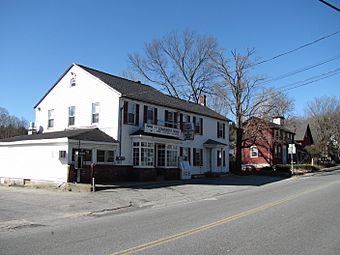Dunstable Center Historic District facts for kids
Quick facts for kids |
|
|
Dunstable Center Historic District
|
|

Pleasant Street
|
|
| Location | High, Highland, Main, & Pleasant Sts., Dunstable, Massachusetts |
|---|---|
| Area | 150 acres (61 ha) |
| NRHP reference No. | 100003069 |
| Added to NRHP | November 5, 2018 |
The Dunstable Center Historic District is a special area in Dunstable, Massachusetts. It's like the heart of the town! This historic district is found where Main, High, and Pleasant Streets meet. This spot has been the town's main center since 1791. That's when the town's church was moved here. Today, the district has many different kinds of old homes and public buildings. It was added to the National Register of Historic Places in 2002. This means it's a very important historical place!
Discovering Dunstable Center's Past
How Dunstable Town Center Grew
The town of Dunstable started way back in 1673. It was a very big area at first, stretching from Milford, New Hampshire all the way to Tyngsborough, Massachusetts. For a long time, the town grew slowly. Most people worked on farms until the mid-1900s.
Over the years, Dunstable's borders changed. Some parts became new towns, like Tyngsborough in 1809. The border between Massachusetts and New Hampshire was also set in 1740.
In 1753, the people of Dunstable decided to build a new church. It was on Meeting House Hill, about 1 mile (1.6 km) east of where the town center is now. But by 1791, more people were living in the western part of town. So, they moved the church to the current town center. A schoolhouse was also built nearby.
Historic Buildings in the Center
The original church and school from 1791 are no longer standing. But the current Evangelical Church is on the same spot. It's a beautiful building from 1913. An old schoolhouse from 1825 is also nearby. It's now used for public works.
The historic district covers about 150 acres (61 hectares). It's centered around the four-way crossing of Main, High, and Pleasant Streets. Besides the church, there are other important public buildings. Roby Memorial Hall was built in 1908 and serves as the town hall. The Union School, built in 1895, is another classic building.
You can still see three houses from the 1700s in the center. These homes show what life was like when the town center was first developing. The old cemetery from 1754 is also part of the district. It was created to replace an even older one on Meeting House Hill.



